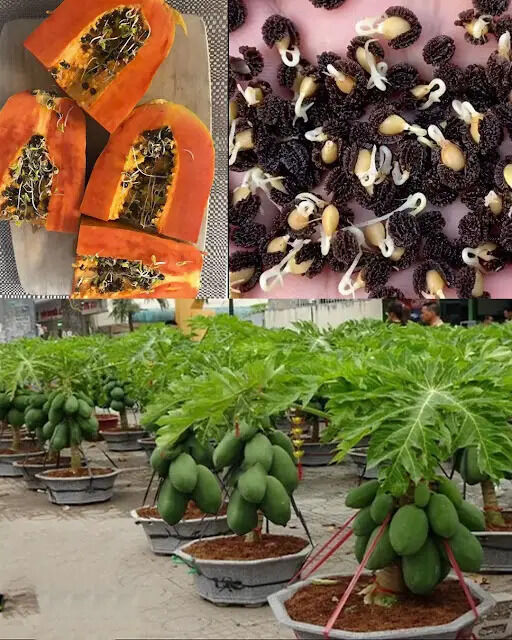ADVERTISEMENT
**Grow Papaya at Home in Pots: The Secret for an Abundant Harvest**
Papaya, with its sweet and tropical flavor, is a favorite fruit for many. It’s not only delicious, but also packed with vitamins, antioxidants, and digestive enzymes that are great for your health. If you’ve always dreamed of growing your own papaya but don’t have a large garden or live in a warm climate, don’t worry! You can easily grow papaya at home in pots. In fact, growing papayas in containers can be incredibly rewarding and result in a bountiful harvest if done correctly.
In this guide, we’ll walk you through the steps to successfully grow papaya at home in pots, so you can enjoy fresh, homegrown papayas right from your own balcony or patio.
—
### 🌱 Why Grow Papaya in Pots?
Growing papaya in pots offers a variety of benefits, especially for those living in smaller spaces or cooler climates where papayas wouldn’t typically grow outdoors.
– **Space-Saving**: Papayas can grow quite large, but by using pots, you can control their size and grow them in smaller spaces like patios, balconies, or even inside your home.
– **Mobility**: Pots allow you to move the plant to follow the sun’s movement or protect it from harsh weather, such as cold snaps or heavy rain.
– **Controlled Environment**: Containers provide better control over the soil, drainage, and water conditions, which can help the plant thrive.
– **Faster Harvest**: Growing papayas in pots tends to speed up their growth, and you might be able to harvest fruit sooner than you would from a ground-planted tree.
—
### 🛒 What You’ll Need to Get Started
Before you start planting, make sure you have all the necessary tools and materials for growing papaya in pots.
– **Papaya seeds or young papaya plants**: You can start from seeds, or if you prefer a quicker start, buy a young plant from a nursery.
– **Large, well-draining pots**: Choose pots that are at least 18-24 inches deep and wide. Papayas need plenty of space for their roots to grow.
– **Good quality potting mix**: A well-draining, slightly acidic potting mix is ideal. A mix designed for tropical plants works best.
– **Compost or organic fertilizer**: Papayas are heavy feeders, so nutrient-rich soil will help them thrive.
– **Watering can or hose**: Papayas need regular watering, but they don’t like sitting in waterlogged soil, so proper drainage is key.
– **Sunlight**: Papayas love full sun, so choose a spot where they’ll get at least 6-8 hours of sunlight daily.
—
### 🌞 Step-by-Step Guide to Growing Papaya in Pots
#### 1. **Choose the Right Variety**
Not all papaya varieties are suited for container growing, so make sure you select a dwarf or compact variety for best results. Varieties like **“Solo”**, **“Sunset”**, or **“Red Lady”** are great options for pot cultivation.
#### 2. **Prepare the Pot**
Select a large pot that has good drainage holes at the bottom. Papayas need well-draining soil, so ensure that excess water can easily escape. If you’re using a plastic pot, consider drilling additional holes if needed. You can place a layer of gravel at the bottom of the pot to further improve drainage.
#### 3. **Plant the Seeds or Seedlings**
If starting from seeds, sow the papaya seeds about **1/2 inch deep** in the potting mix. Keep the soil moist but not soggy, and place the pot in a warm, sunny location. The seeds should sprout in about 2-4 weeks. If you’re starting with seedlings, gently transplant them into the pot and make sure the root ball is not disturbed too much.
#### 4. **Position the Pot in Full Sun**
Papayas love the sun! Place your pot in a location that gets **at least 6-8 hours of direct sunlight** each day. Ideally, this should be a south-facing spot if you’re in the northern hemisphere. Papayas thrive in warm temperatures, so ensure the plant stays in a sunny spot, especially during the growing season.
#### 5. **Watering and Drainage**
Papayas require regular watering, especially when they’re young. However, they don’t like to sit in water, so make sure the pot has excellent drainage. Water the plant deeply, but allow the top inch of soil to dry out before watering again. During hot summer months, you may need to water more frequently.
#### 6. **Fertilizing**
Since papayas are heavy feeders, providing regular nutrients is essential for healthy growth. Use a **balanced, organic fertilizer** or a high-nitrogen fertilizer to encourage healthy leaf growth. You can also amend the soil with compost to improve its fertility. Fertilize your papaya every 6-8 weeks during the growing season for optimal results.
7. **Pruning and Care**
Prune your papaya plant regularly to remove dead or damaged leaves and encourage airflow. This will help prevent fungal diseases and allow the plant to focus its energy on growing strong. Papayas naturally have a single trunk, so don’t worry about excessive pruning unless you want to shape the plant.
For Complete Cooking STEPS Please Head On Over To Next Page Or Open button (>) and don’t forget to SHARE with your Facebook friends
ADVERTISEMENT
